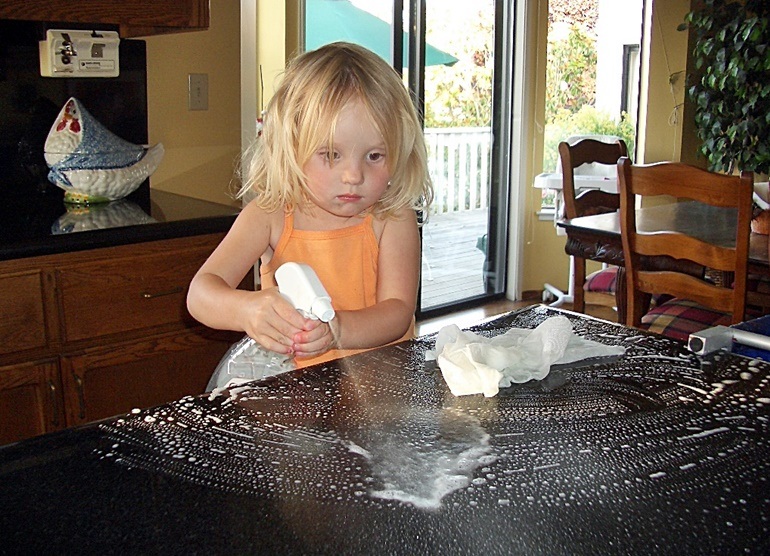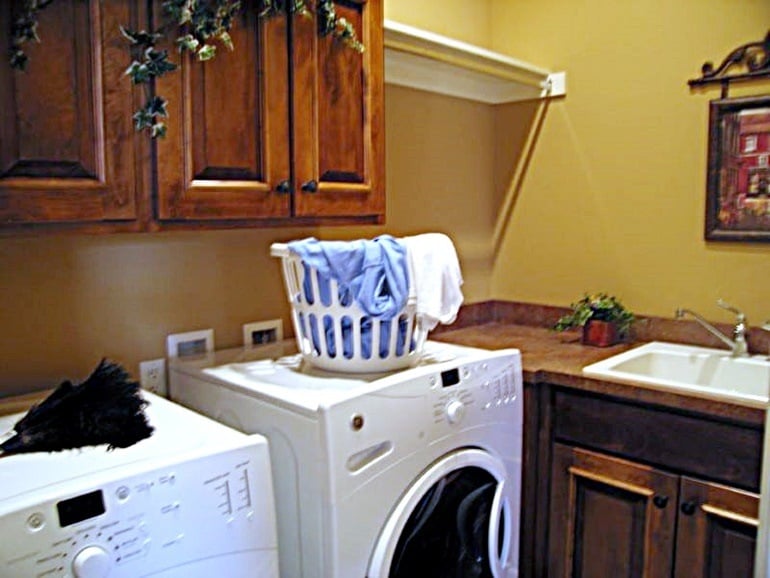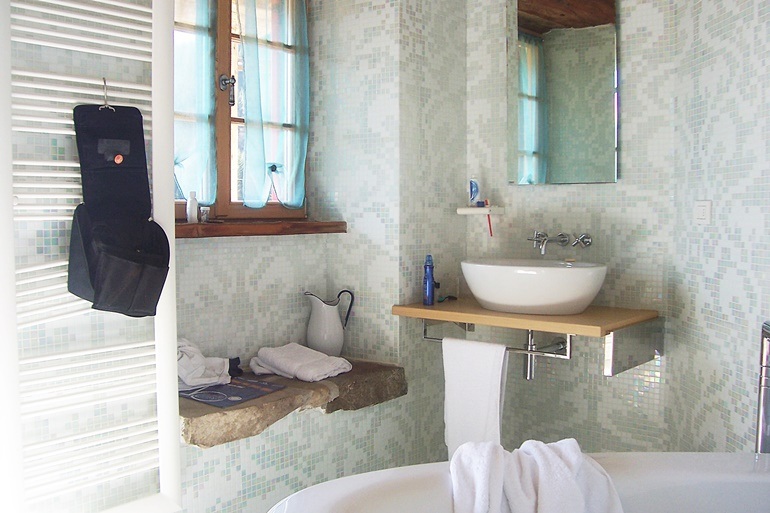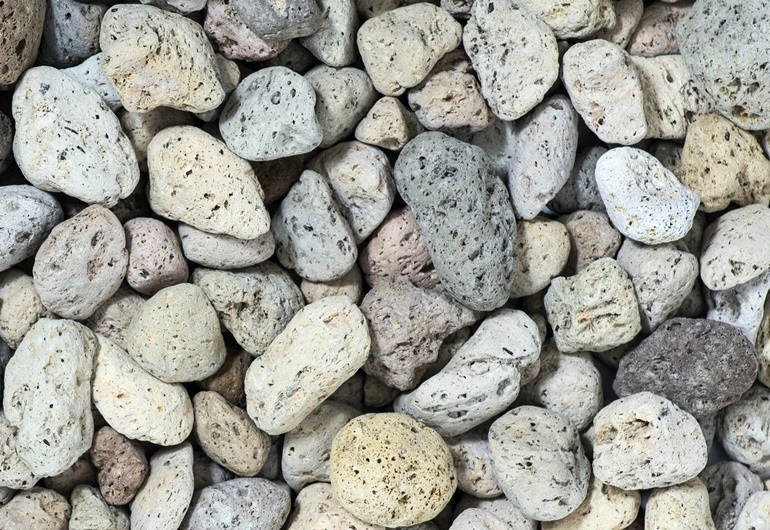Let me be honest: cleaning is not my favorite thing to do. Moreover, unpleasant odors and the air-contaminating nature of commercial cleaners always troubled me and caused me to put off cleaning. We know most commercial cleaners are harmful to our health and the environment. The challenge is to make an old habit into a new lifestyle. You can find the health and environmental effects of commercial cleaning products by checking the EWG rating by Environmental Working Group. The rating criteria include concerns with asthma, skin irritation, and cancer. Try looking up your “natural” commercial cleaner’s rating. In search of more pleasant and natural cleaning methods, I dumped all commercial cleaning products and replaced them with non-toxic homemade cleansers about a year ago. I can breathe much better while cleaning, and I am very pleased with this lifestyle change, which will last for the rest of my life. More importantly, these homemade cleaners not only efficiently clean almost anything, but also often work better than commercial cleaners. These are cost-effective too. The essentials: I keep vinegar, citric acid powder, and baking soda readily available, each in its own plastic sauce bottle.
Biodegradable cleaner is especially suited for removing grease such as oily tableware and cookware. I use Dr. Bronner’s Sal Suds biodegradable liquid cleaner, which gets an A grade on the EWG rating. Castile soap is mainly made from olive oil and/or coconut oil and is safely used for body cleaning. It is milder and more versatile than Sal Suds biodegradable cleaner, but may be less economical for cleaning purposes.
The following are useful cleaning tools that will save your time. While not biodegradable, these are considered non-toxic – and also save water.
Melamine sponges make your cleaning life much easier in various ways. The secret of the “magic” is that a melamine sponge works like super-fine sandpaper. Other than Mr. Clean Magic Eraser, you can buy inexpensive alternatives with the same quality at discount stores or online. (Note: an ingredient of melamine sponges called formaldehyde-melamine-sodium bisulfite copolymer is not the same as a toxic chemical formaldehyde.) Microfiber cloths trap dust and wipe dirt without leaving lint on the surface, due to their ultra-fine synthetic fibers.
Note: Before applying any of the cleaning methods below, I recommend testing first at an inconspicuous area.
Everyday Cleaning
1. Take Advantage of Melamine Sponges, and Keep All-Purpose Sprays Made of Vinegar, Citric Acid, and/or Biodegradable Soap Handy
Melamine sponges are surprisingly versatile. With just a little water, it even removes permanent marker and cleans sneakers’ surfaces. While a melamine sponge cleans just about anything, it is not recommended to use for glossy or varnished surfaces in order to avoid scratches. You can cut the sponge with a kitchen knife to small pieces for handy uses. Although it is reusable, it shrinks as you use. All-purpose Homemade Cleaners:
Vinegar solution Mild: 1 tablespoon distilled white vinegar + 1 cup water Strong: 1 cup distilled white vinegar + 1 cup water Citric acid solution Mild: 1 teaspoon citric acid powder + 1 cup water Strong: 2 ½ teaspoons citric acid powder + 1 cup water Dishwashing soap Mild: ¾ teaspoon Sal Suds + 1 cup water + optional: a few drops tea tree oil Strong: 2 teaspoons Sal Suds + 1 cup water + optional: 5-10 drops tea tree oil
Keep each solution handy in its own labeled spray bottle. Strong solutions do not mean harsh solutions. Personally, I use strong solutions for almost any cleaning. You can adjust the proportion of a solution according to your needs. Above all, a combination of a melamine sponge and a strong citric acid solution works best to remove tough stains on various surfaces quickly and easily. Baking soda can also be added in the vinegar solution, though the mixture leaves somewhat dull texture on the surface. Baking soda in this use mainly acts as scouring powder, but a melamine sponge works better for this purpose. Citric acid solutions above have stronger acidity than that of vinegar solutions above because an acetic acid in white vinegar is already diluted by water to only 5 percent, whereas acid in citric acid powder is 100 percent. Vinegar or citric acid powder can also be used without adding water for some cleaning. Dishwashing soap above is based on Dr. Bronner’s Sal Suds biodegradable cleaner, which is concentrated. Please follow appropriate measurement of the particular biodegradable soap. Tea tree essential oil is widely used as an antibacterial agent.
2. Shine Windows and Mirrors with Microfiber Cloths, Melamine Sponges, Vinegar, or Citric Acid
To wipe off dust on windows or mirrors, use a dry microfiber cloth or dry melamine sponge. For heavy cleaning, clean with a slightly moist melamine sponge or microfiber cloth. You can also use an extra-mild solution (1 teaspoon of vinegar and 1 cup of water, or ¼ teaspoon of citric acid and 1 cup of water). Finish with a dry microfiber cloth to remove water residue. To remove tough water residue or streaks, fine steel wool works quickly. Although steel wool does not scratch ordinary glasses, it is always safe to test the surface first.
3. Freshen Your Room with Rubbing Alcohol Spray, or Eliminate Room Odors with Vinegar or Baking Soda
Rubbing alcohol (isopropyl alcohol) spray removes room odors quickly – this certainly works! Optionally, you can add a few drops of essential oils that have a deodorant property, such as lavender, to diffuse a pleasant scent. Vodka spray also seems to work, though I haven’t tried that yet. Another way to remove room odors is to leave a bowl filled with vinegar or baking soda in a room.
Laundry
4. Wash Clothes with Biodegradable Cleaner
A commercial detergent Tide Free & Gentle, which I used for years, is labeled “Free of Dyes & Perfume; Dermatologist Tested.” Nonetheless, I was stunned to find an F grade on the EWG rating. Sal Suds biodegradable cleaner washes clothing well, yet is not harsh on the skin. I use 1-3 tablespoons, depending on the load. Alternatively, washing soda or Castile soap can be used to clean clothes. Optionally, baking soda can be added in the wash cycle to remove odors and whiten clothes.
5. Rinse Laundry with Vinegar, and Dry Clothes Faster with Wool Dryer Balls
White vinegar (¼ cup-1 cup, depending on the load) can be added in the rinse cycle. It softens clothing without leaving the vinegar smell. Why does this work? It is an alkali and acid reaction: an acid of vinegar neutralizes the clothes soaked with alkaline soap. The vinegar softener also works well with laundry with a commercial detergent. A word of caution: Do not add vinegar in the wash cycle – doing so will cancel out effectiveness of cleaning ability. Dryer balls soften laundry and shorten drying time: they keep clothes from tangling by bouncing around inside the dryer. The more balls (3-6) you use, the faster your clothes will dry. An eco-friendly option would be 100 percent wool dryer balls rather than their plastic or rubber counterparts.
Bathroom
6. Make Toilet Bowls Sparkle with Vinegar or Citric Acid
Commercial toilet bowl cleaners are among the harshest with a strong smell and eye-irritating agents. You can clean a toilet bowl in a more pleasant way. For regular cleaning, spray vinegar or a strong citric acid solution (2 ½ teaspoon of citric acid and 1 cup of water), and leave it for 15 minutes to 1 hour (the longer, the better). Scrub with a brush, and flush. Alternatively, you can spray dishwashing soap, though I found it is less effective for this cleaning. For deep cleaning, spray a strong citric acid solution, and sprinkle ½ cup of citric acid powder inside the toilet bowl including under the rim. The powder kept in a sauce bottle serves nicely for this job. Optionally, you can add ¼-½ cup of baking soda. Leave it for an hour to several hours. Scrub thoroughly with a brush, and flush well. Now you have a shiny toilet bowl! When you see black streaks running from under the rim inside the toilet bowl, it may be caused by mold in the toilet tank. To prevent this, periodically add 1 tablespoon of baking soda into the toilet tank.
7. Cleanse Bathtubs and Sinks with Citric Acid or Biodegradable Soap
After I tried everything for cleaning a bathtub – from vinegar and baking soda to grapefruit and salt, I chose citric acid as a winner. It cleans thoroughly with ease. Spray a citric acid solution (1-2 ½ teaspoons of citric acid and 1 cup of water) inside the bathtub, sprinkle citric acid powder, and leave it for 30 minutes or more. Scrub with a scouring pad or melamine sponge. If needed, spray an additional citric acid solution when scrubbing. Dishwashing soap can clean the tub quickly without waiting time, though it is better to leave it for a while so that the dirt comes off more effortlessly. To clean a sink, spray a citric acid solution or dishwashing soap. Leave it for 15 minutes and scrub. For stubborn stains, spray vinegar or a strong citric acid solution (2 ½ teaspoon of citric acid and 1 cup of water) over the stain, and lay a paper towel over it. Spray the solution again over the paper towel, and cover the area with plastic wrap to keep from drying. Leave it for several hours before scraping off the stain.
8. Wipe Away Soap Scum on Glass Shower Doors with Melamine Sponges and Citric Acid
Without too much effort, you can restore a murky glass shower door to a translucent door! Spray a citric acid solution (1-2 ½ teaspoons of citric acid and 1 cup of water) on shower doors, leave it for several minutes, and rub it off with a melamine sponge. Soap scum comes off effortlessly. Wipe away the scum on the surface with a microfiber cloth or a paper towel. You may need to repeat this process a few times until you no longer see white streaks on the door surface.
9. Destroy Calcium and Lime Deposits on Faucets with Vinegar
The spout head of a faucet can easily get stains from buildup of hard water minerals. A vinegar pack serves well to remove this. Pour a small amount of vinegar into a fold-top sandwich bag. Wrap it around a faucet’s spout head, soaking the stain in vinegar, and fix it with a rubber band. Leave it for several hours before scraping away the stain. To restore the shine on the faucet body and handle, water residue can be wiped away with a dry microfiber cloth or a paper towel moistened with a vinegar or citric acid solution.
10. Kill Mold and Mildew with Hydrogen Peroxide or Vinegar, and Prevent the Regrowth with Tee Tree Oil
To get rid of mold and mildew, spray hydrogen peroxide (3 percent), and leave it for 10-20 minutes. Wipe off, and allow the surface to dry completely. Alternatively, vinegar works too. Leave it for one hour before wiping. (Caution: Don’t mix vinegar and hydrogen peroxide as it may produce a harmful acid.) To prevent mold and mildew spores from growing, spray a tea tree oil solution (1 teaspoon of tea tree essential oil and 1 cup of water). Do not wipe away, and let it dry.
11. Unclog Drains with Baking Soda and Vinegar
To unclog the drain, pour a mixture of ½ cup of baking soda and ½ cup of vinegar into the drain. Leave it for 15 minutes, and pour hot water.
Kitchen
12. Clean Tableware with Melamine Sponges or Biodegradable Soap
A melamine sponge with a little water easily cleans tough stains and rust on porcelain, silverware, knives, and plastic with a non-glossy surface. To remove grease, use a small amount of dishwashing soap (¾-2 teaspoons of Sal Suds and 1 cup of water, for example). In most cases, hot water with a cellulose sponge or melamine sponge does a sufficient job when cleaning non-greasy, non-smelly tableware by hand, thereby also saving water. Cellulose sponges are biodegradable and mostly made from plants such as wood pulp and cotton fiber.
13. Let Stainless Steel Cookware Glitter with Vinegar or Citric Acid and Melamine Sponges
You can restore the shine of cloudy stains inside stainless steel saucepans in 10 minutes. Pour or generously spray vinegar or a strong citric acid solution (2 ½ teaspoons of citric acid and 1 cup of water) over the stain, leave it for 5-10 minutes, and gently rub it with a melamine sponge. Don’t scrub too hard as doing so can scratch the surface. Also, don’t use a melamine sponge on a glossy surface of stainless steel.
14. Remove Heavy Stains on Ovens and Stove Drip Pans with Baking Soda and Vinegar
To clean brownish buildup stains on stove drip pans, make a paste with baking soda and vinegar, and apply the paste on stains. In order to keep moisture, put each drip pan into a plastic bag separately. Leave it overnight, and scrape off the paste. For inside the oven, cover the area with a plastic wrap after applying the paste.
15. Get Rid of Fruit Wax with Vinegar
To remove wax on fruits or vegetables, put them into an extra-mild vinegar solution (1 tablespoon of vinegar and 1 quart of water) for 10-20 minutes. Alternatively, rub non-porous fruit or vegetable with a scouring pad moistened with vinegar. Personally, I also wash them with hot water.
16. Eliminate Fishy Odor with Lemon Rind or Vinegar
To remove an odor like a fish smell on the tableware or on your hands, rub them with inside of the leftover lemon rind. Otherwise, soak the tableware in a vinegar solution. Dishwashing soap works as well.
17. Wipe off Sticker Residue with Melamine Sponges or Orange Essential Oil
Sometimes you may want to recycle a nice container that has a sticker and date stamp on it. To remove sticker residue, a melamine sponge or a cloth with a few drops of orange essential oil will do wonders. For tough sticker residue on a glass container, fine steel wool works too. A melamine sponge also removes a date stamp on a container, though it can scratch and haze plastic or metal surface. Rubbing alcohol also works on a glass container. Having said that, acetone (nail polish remover) works most effortlessly to remove a date stamp on most materials, but use it sparingly as it is toxic with a large amount.
Living Room
18. Restore White Keyboards and Computer Surfaces with Melamine Sponges
Melamine sponges easily clean finger marks and stains on white keyboards and computers. Years-long stains on my old white MacBook effortlessly wiped out in a few minutes. Gently rub the surface with a slightly moistened melamine sponge.
19. Polish Wooden Furniture with Olive Oil and Lemon Juice
You can polish varnished wooden furniture with an equal part of olive oil (or vegetable oil) and lemon juice (or vinegar).
20. Disinfect Air-Conditioning Filters with Vinegar
To keep indoor air fresh, it is recommended to clean air-conditioning filters every two weeks. (I know it is just an ideal.) Vinegar disinfects the filters. After vacuuming an air-conditioning filter, soak it in a solution of an equal part of vinegar and lukewarm water for 1-4 hours. A large sink may fit to do this job. Don’t rinse the filter; let it dry naturally.
The Last Resort
21. Erase Extremely Tough Stains with Pumice Stone or Sandpaper
When anything else didn’t work in removing an extremely stubborn stain, scraping it off with pumice stone or fine sandpaper could be a solution for non-glossy or unvarnished surfaces. Good luck! Featured photo credit: Baking soda vinegar and lemon on the white background by Focal point via shutterstock.com





